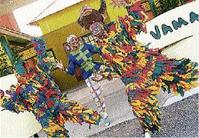Janet Silvera, Senior Gleaner Writer
'Time traveller' Beverly Gordon dances with the Jonkunnus.
A striking sugar mill dating back to 1793 delights the eyes, stimulates the brain and piques the curiosity for the need to enter this time capsule called Outameni Experience, while an imposing Taino and a strapping Rastafarian denote 'One Love'.
Jamaica's newest and most exhilarating attraction has taken the island's hospitality industry several notches up, and whether you are a descendant of the Tainos, Spanish, African, English, Indo-Chinese or Indian, there is pride of place on this fabulous journey.
Giving credence to an unknown area called Coopers Pen, owner, Lennie Little-White, has presented the parish of Trelawny with its first in a series of transformations.
Opened two weeks ago, locals and visitors will be allowed to enter this rich cultural haven, which has been packaged fabulously with Jamaica's diverse history.
Outlook magazine was privileged to experience the rituals and cosmic ride unveiled by 'time traveller', Beverly Gordon, on a recent visit.
But before Gordon takes you on her ride, 'Pitch-Patchy' Jonkunnus paying tribute to the African ancestors who would dress up during the Christmas holidays for their infrequent 'free' day of celebration are the first to welcome you.
Time Traveller's capsule
Music, dancing and a sneak preview into the diversity of this island is followed by the opening of the time traveller's capsule, which reveals an authentic taste, feel and look of Jamaica. Imaginatively summoning what she terms a rainbow of spirits, she chants unfamiliar words, before taking guests on an electrifying journey into the past.
The rich past takes guests into a dirt-floor cave, with etchings of the island's first and most peaceful inhabitants, the Tainos. Stalactites jumping at you from the ceiling, a dugout canoe, a mummified Taino and their god, the Zemi, complement 'present-day' Indians 'Naniki and Atabeh'.
The next stop is with the Spanish, who came here in 1494, having brought religion with them. It was fitting for the entrance to this room to give the look and feel of a church furnished with benches, a stained-glass window and a large cross in the middle of the floor.
To speak of Spain's influence on Jamaica and not have Christopher Columbus in the mix would be foolhardy, so the designers made sure a young white European man took ownership at one end of the room, while one of three ships to arrive here during the period, the Santa Maria, and large pimento barrels showcased the richness therein.
From Spain, which introduced African slaves to Jamaica, the experience that followed was probably the most painful - as each guest takes a step into the 'Middle Passage'. Dark and claustrophobic, an undulating floor of timber platforms that gives the feeling of being in the bowels of a ship was the precursor to being greeted by a square with a proverbial cotton tree.
Narrow walls, low ceilings, an overseer's house, and a noose hanging from the cotton tree, clothes hanging from the line, a wattle-and-daub house with a hardwood bed cushioned with banana trash and small huts resembling cells made this area extremely special.
English era
The next stop was 1655, and as you entered this room, the large cannons signalled the start to the era of the English.
Aqueducts, a colonial-times-looking town square, an English planter and the dance that they brought with them - the Maypole - were there.
Soon it was time to take leave of the over 300 years of slavery and get a reflection of the lives of the indentured servants, the
Chinese and the Indians. Mr. Chin's shop, an Indian in a Tazia, led the passage to Jamaica today.
Passa Passa, handcarts, inner-city communities, zinc fences with graffiti bearing vote PNP and JLP play host to a modern metropolis with several booming industries showcasing the rich diversity of the country called Jamaica.
This immensely creative journey telling the country's history had behind it some key players, including project manager Cheryl Ryman, architect Evan Williams, colour designer Raye Addison and the architect for the set design, Michael Lorde.
Franklyn St. Juste, Barry Moncrieffe, Pam Sutherland, Winston Patrick and Kojovi Dawes, a student at Edna Manley, all contributed to its uniqueness.

